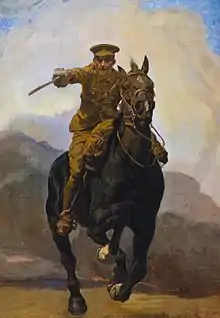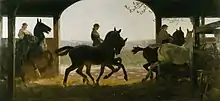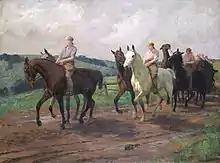Lucy Kemp-Welch
Lucy Elizabeth Kemp-Welch (20 June 1869 – 27 November 1958) was a British artist and teacher who specialised in painting horses. Though increasingly overlooked after the Second World War, from the late 1890s to the mid-1920s she was one of the country's best-known female artists. As her obituary in The Times noted, 'Like most artists who came to maturity and were established before the end of the nineteenth century, Lucy Kemp-Welch suffered somewhat in her later reputation from the violent changes in art which followed. In her prime as an animal painter she held a position in this country comparable to that of Rosa Bonheur in France, and the only British woman artist of her generation who was more talked about was Lady Elizabeth Butler, painter of "The Roll Call".'[1] Her reputation has since revived, and she is best known today for her large paintings of wild and working horses in the New Forest, and those in military service which she produced during the First World War, as well as for her illustrations to the 1915 edition of Anna Sewell's novel Black Beauty.
Lucy Kemp-Welch | |
|---|---|
 | |
| Born | 20 June 1869 |
| Died | 27 November 1958 (aged 89) |
| Nationality | British |
| Education | The Herkomer School |
| Known for | Equine artist |
Biography
Early life
Lucy Kemp-Welch was born in Bournemouth, the first child of solicitor Edwin Buckland Kemp-Welch, a solicitor and amateur naturalist. She showed an early excellence in art and exhibited for the first time when she was 14 years old. After attending a local art school, in 1892 she and her younger sister Edith moved to Bushey, Hertfordshire to study at Hubert von Herkomer’s art school.[2] As one of Herkomer's best and most favoured students, she was able to set up her own studio, in an old former inn known as 'Kingsley'. In 1905 Kemp-Welch took over the Herkomer School, and ran it until 1926, first as the Bushey School of Painting and then, after relocating it to premises in the garden of her own home, as the Kemp-Welch School of Animal Painting. After 1928 the school was run by Kemp-Welch's former assistant Lucy Marguerite Frobisher as the Frobisher School of Art.[3]
While still a student Kemp-Welch had a painting Gypsy Drovers taking Horses to a Fair shown at the Royal Academy in 1895.[3] Kemp-Welch received further public recognition in 1897 when her painting Colt-Hunting in the New Forest was also shown at the Royal Academy Summer Exhibition.[2] The painting was purchased by the Chantrey Bequest for 500 guineas, and is now in the British national collection at the Tate.[4][5] In total, throughout her career Kemp-Welch had 61 paintings displayed at the Royal Academy.[6]
The success of Colt-Hunting in the New Forest led many to believe that Kemp-Welch would be elected to the Royal Academy but although she was nominated at least twice, she was not elected.[2] In 1902 she was elected to the Royal Society of British Artists alongside Louise Jopling, becoming with her the first women to be admitted.[2][7] In 1914 she became president of the Society of Animal Painters.[3] In 1915 she provided illustrations to an edition of Anna Sewell's Black Beauty, using Robert Baden-Powell's horse Black Prince as a model.[3] She had previously illustrated Round About, A Brighton Coach Office by M E King in 1896 and The Marking of Mathias in 1897.[8] As well as pictures of horses, Kemp-Welch painted other animals, flowers and landscapes. She also painted at least two Boer War scenes, In Sight: Lord Dundonald's dash on Ladysmith, 1901 (Royal Albert Memorial Museum, Exeter), and Sons of the City (private collection). Both of these featured horses in military action and led to several significant commissions for her during World War One.
World War One


In December 1914, Kemp-Welch was engaged by the British Parliamentary Recruiting Committee to paint the artwork for the famous army recruitment poster Forward! Forward to Victory Enlist Now, which she signed 'L.K.W 1914.'[9]
During World War One, women were employed at Army Remount Depots in training and preparing horses for military service. Kemp-Welch was commissioned by the Women's Work Section of the Imperial War Museum to paint a scene at the largest such depot, one staffed entirely by women, at Russley Park in Wiltshire.[10] The museum authorities were unhappy with the painting, The Ladies Army Remount Depot, Russley Park, Wiltshire, which Kemp-Welch first submitted but were aware of a larger and better composition on the same subject that she had painted and intended to sell to a private client for £1,000. Kemp-Welch agreed that the second painting, The Straw-Ride – Russley Park Remount Depot Wiltshire was the better of the two and agreed to sell it to the IWM to fulfil her commission. However, she was unable to agree a fee with the Women's Work Section and after protracted discussions, donated it to the museum.[11][12]
In 1916, Kemp-Welch sought and was given permission to visit the Royal Field Artillery camp at Bulford on Salisbury Plain. The officer in command of the camp allowed her to set up an easel while eight batteries of horse artillery were continually ridden towards her so she could sketch the horse teams in movement at close quarters.[13] These sketches resulted in two large works: The Leaders of a Heavy Gun Team, now in the Royal Artillery Institution, and Forward the Guns.[14][15] These paintings were shown at the Royal Academy in 1917 and Forward the Guns was purchased by the Chantrey Bequest for the Tate. Although popular images at the time, these painting are not without their critics as they provided a heroic view of warfare which was at odds with the reduced role of horse artillery in an increasingly mechanised conflict.[14]

As well as Bulford Camp, Kemp-Welch also made studies at several other Royal Artillery camps, notably several in Hampshire near Winchester. The resulting pictures included Big Guns to the Front, an image of shire horses pulling guns through a snowy landscape, which was shown to great acclaim at the Royal Academy in 1918 and was purchased for the National Museum of Wales in 1921.[16]
Later life
In 1924, for the Royal Exchange, Kemp-Welch designed and completed a large panel commemorating the work of women during World War One.[17] From 1926 onwards she focussed on depicting scenes of gypsy and circus life and spent several summers following Sanger's Circus, recording the horses.[2][18]
Kemp-Welch resided in Bushey, Hertfordshire for most of her life, never marrying.[19] A major collection of her works is held by Bushey Museum.[20] They include very large paintings of wild ponies on Exmoor, galloping polo ponies, the last horse-launched lifeboat being pulled into a boiling sea, heavy working horses pulling felled timber and hard-working farm horses trudging home at the end of the day. The Lucy Kemp-Welch estate has been represented by Messum's Fine Art since 1975.
Family
Lucy Kemp-Welch's younger sister Edith, was also an artist, and studied at Herkomer's school. She occasionally exhibited at the Royal Academy, and lived her adult life at 'Kingsley' with her sister, until her death from cancer in 1941.[21] Their cousin Margaret Kemp-Welch (1874–1968) was also an artist, and likewise trained at Herkomer's School. In 1915 Edith produced a poster for the British war effort, featuring an image of Britannia with the slogan "Remember Scarborough," a reference to the shelling of the Yorkshire seaside town by German warships.[22]
Lucy's live-in companion, Marguerite Frobisher, was buried with her when she died in 1974.[23]
References
- The Times, 28 November 1958
- David Boyd Haycock (29 March 2023). "Lucy Kemp-Welch: a passionate painter of horses". Art UK. Retrieved 4 April 2023.
- David Buckman (1998). Artists in Britain Since 1945 Vol 1, A to L. Art Dictionaries Ltd. ISBN 0-95326-095-X.
- Alicia Foster (2004). Tate Women Artists. Tate Publishing. ISBN 1-85437-311-0.
- Tate. "Catalogue entry for Colt hunting in the New Forest". Tate. Retrieved 22 July 2014.
- Marion Whybrow (1994). St Ives 1883-1993 Portrait of an Art Colony. Antique Collectors' Club. ISBN 1851491708.
- The Gentlewoman and Modern Life (London), 22 March 1902.
- Simon Houfe (1996). The Dictionary of 19th Century British Book Illustrators. Antique Collectors' Club. ISBN 1-85149-1937.
- Nigel Steel (Introduction) (2014). Posters of the First World War. Imperial War Museum. ISBN 978-1-904897-87-3.
- Kathleen Palmer (2011). Women War Artists. Tate Publishing/Imperial War Museum. ISBN 978-1-85437-989-4.
- Merion Harries & Susie Harries (1983). The War Artists, British Official War Art of the Twentieth Century. Michael Joseph, The Imperial War Museum & the Tate Gallery. ISBN 0-7181-2314-X.
- Catherine Speck (2014). Beyond the Battlefield, Women Artists of Two World Wars. Reaktion Books. ISBN 978-178023-374-1.
- A Historical Dictionary of British Women. Europa Publications. 1989. ISBN 1857432282.
- Richard Cork (1994). A Bitter Truth - Avant Garde Art and the Great War. Yale University Press & The Barbican Art Gallery.
- Tate. "Catalogue entry for Forward the Horses". Tate. Retrieved 22 July 2014.
- National Museum Wales. "Big Guns to the Front". Art Collections Online. Retrieved 1 January 2016.
- Cathy Hartley, ed. (2003). A Historical Dictionary of British Women. Europa Publications. ISBN 1857432282.
- Frazer Ansell (22 January 2015). "Bushey artist Lucy Kemp-Welch's painting sells for more than £20,000". Watford Observer. Retrieved 1 January 2016.
- "18 Lucy Kemp-Welch (1869-1958)". 18 Lucy Kemp-Welch (1869-1958). Retrieved 12 June 2021.
- "18 Lucy Kemp-Welch (1869-1958)". 100 Greatest Women Artist, so far.. Retrieved 11 June 2021.
- Brian Stewart & Mervyn Cutten (1997). The Dictionary of Portrait Painters in Britain up to 1920. Antique Collectors' Club. ISBN 1-85149-173-2.
- Imperial War Museum. "Remember Scarborough". Imperial War Museum. Retrieved 31 December 2015.
- "Grave of Bushey artist is restored". Watford Observer. Retrieved 18 February 2022.
Further reading
- Harrington, P. (1993). British artists and war: The face of battle in paintings and prints 1700-1914. London: Greenhill. ISBN 1-85367-157-6
- Haycock, David Boyd (2023). Lucy Kemp-Welch: Painter of Horses. London: Antique Collectors Club. ISBN 1788842243
- Messum, D. (1976). Life and Work of Lucy Kemp-Welch. London: Antique Collectors Club. ISBN 0-902028-43-X
- Wortley, L. (1996). Lucy Kemp-Welch, 1869-1958: The Spirit of the Horse. London: Antique Collectors Club. ISBN 1-85149-252-6
External links
- 42 artworks by or after Lucy Kemp-Welch at the Art UK site